Reserve Bank of Australia Annual Report – 2015 Operations in Financial Markets
The Reserve Bank transacts in domestic and international financial markets in order to meet the Bank's policy objectives. These transactions include implementing the monetary policy decisions of the Reserve Bank Board, facilitating smooth functioning of the payments system, managing the nation's foreign reserve assets, providing banking services to clients (mainly the Australian Government and its agencies and foreign central banks) and issuing banknotes.
Balance Sheet
The Reserve Bank's balance sheet is affected by the range of transactions undertaken in domestic and international financial markets to meet the Bank's policy objectives.
The balance sheet increased by around $15 billion over 2014/15. On the liabilities side, the increase reflected the issuance of banknotes and higher deposit balances held by clients, particularly deposits held by the Australian Government, which increased by around $6 billion over the financial year. These deposits are used by the Government to ensure that its financial obligations are able to be met as and when they fall due, and can vary considerably over the course of a year.[1] Banknotes on issue rose by around $5 billion over 2014/15. The increase in liabilities was accommodated on the assets side of the balance sheet predominantly by an increase in domestic securities held under reverse repurchase agreements (repos).


Domestic Market Operations
Management of System Liquidity
The Reserve Bank Board's operational target for monetary policy is the cash rate – the rate at which banks borrow and lend to each other on an overnight, unsecured basis. The cash rate target was changed twice during the past year – from 2.5 per cent to 2.25 per cent in February 2015 and from 2.25 per cent to 2 per cent in May 2015.
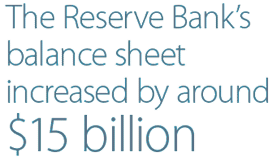
To assess whether the target has been achieved, each day the Reserve Bank collects data from Exchange Settlement (ES) account holders on their unsecured borrowing and lending in the overnight interbank market. Aggregate activity within the cash market averaged around $5 billion each business day over the financial year. The weighted-average cash rate was equal to the Board's target on all days.
To implement the cash rate target, the Reserve Bank operates in financial markets each day to maintain an appropriate level of ES balances, which are liabilities of the Bank and are used by financial institutions to settle their payment obligations with each other and with the Bank. Of the 174 members of the Reserve Bank Information and Transfer System (RITS), 88 members hold ES accounts. The supply of ES balances is altered by payments between ES account holders (mainly financial institutions) and the Reserve Bank (including its customers, principally the Australian Government). To offset these flows, the Bank can buy or sell government securities, undertake transactions in the repo market or use foreign exchange swaps.
The Reserve Bank announces its intentions for its open market operations each morning at 9.30 am. Those wishing to participate in the Bank's open market operations have a 15-minute window in which to register their approaches for the auction that determines the Bank's liquidity injection. The results of the Bank's main round of open market operations are announced shortly after 9.45 am. To ensure that unforeseen payments do not adversely affect the Bank's ability to implement monetary policy, the Bank has the option of undertaking additional rounds of market operations late in the afternoon. The Bank announces its intention to deal (or not to deal) at 5.10 pm every day; there have been 58 such additional dealing rounds during the past financial year, with two-thirds of these operations to inject liquidity. In the event of unforeseen liquidity developments later than this, further additional rounds can be announced if the need arises, but no such operations were required in 2014/15.
Surplus ES balances are remunerated at 25 basis points below the cash rate target; conversely, where an ES account holder faces a shortfall in ES balances, the Reserve Bank is willing to advance funds overnight against eligible securities at an interest rate 25 basis points above the cash rate target. During 2014/15, ES account holders sought overnight funding from the Bank on two separate occasions for small amounts.
The Reserve Bank seeks to maintain a supply of surplus ES balances sufficient to ensure that the interbank cash market clears at the Board's target.[2] In recent years, the supply of surplus ES balances had been reasonably steady at around $1 billion; however, over the past year there has been an increase in the size and volatility of surplus funds. From January 2015, surplus ES balances increased to around $1½ billion and were typically in a range of $500 million around this average. In part, this reflects an increase in demand for ES balances by some institutions following the introduction of the Liquidity Coverage Ratio (LCR). This reflects the fact that ES balances are high-quality liquid assets (HQLA), which institutions are required to hold in sufficient quantity to satisfy the LCR. In response to this additional demand, the Reserve Bank increased the quantity of surplus ES balances supplied in open market operations. This ensured that sufficient funds were available in the cash market for all institutions to meet their payment obligations and that the market cleared at the Board's target on all days.
| Number of occasions funding sought |
Average value of funding provided $ million | |
|---|---|---|
| 2009/10 | 5 | 207 |
| 2010/11 | 2 | 182 |
| 2011/12 | 5 | 221 |
| 2012/13 | 2 | 94 |
| 2013/14 | 7 | 194 |
| 2014/15 | 2 | 38 |
|
(a) Includes overnight repos and exchange settlement account balance shortfalls relative to open RBA repo positions Source: RBA |
||
Committed Liquidity Facility
The Australian Prudential Regulation Authority (APRA) implemented the Basel III liquidity standard in Australia from 1 January 2015. The standard requires banks subject to the LCR to hold sufficient HQLA to meet outflows during a 30-day period of stress. Given the relatively low levels of government debt and hence a shortage of HQLA in Australia available to the banks subject to the LCR, the Reserve Bank introduced a committed liquidity facility (CLF). The CLF provides banks with a contractual commitment to funding under repurchase agreements with the Reserve Bank, subject to certain conditions. These include that banks pay a fee of 15 basis points per annum on the amount committed and that any bank seeking to utilise the CLF must have positive net worth in the opinion of the Reserve Bank, having consulted with APRA. The banks are able to contract these repos using eligible securities (including self-securitisations). The full terms and conditions of the facility are available on the Bank's website.[3]
The Reserve Bank administers the CLF, while APRA determines which banks have access and the amount available. For the calendar year 2015, the Reserve Bank entered into commitments with 13 banks and the total size of the facility was $275 billion at 30 June 2015. The aggregate size of the facility is the difference between APRA's assessment of banks' overall LCR requirements less the Reserve Bank's assessment of the amount of Australian Government Securities (AGS) and semi-government securities (semis) that could reasonably be held by banks without unduly affecting market functioning. In 2015, these amounts were $450 billion and $175 billion, respectively. The size of the commitment granted to each bank will be reviewed annually by APRA, while the Reserve Bank will make an annual assessment of the overall amount of government securities that can reasonably be held by the banks as HQLA.
Holdings of Domestic Assets
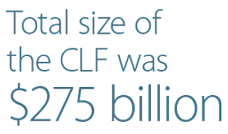
The size of the Reserve Bank's asset holdings is generally determined by changes in its liabilities. Over the past year, the Bank's holdings of domestic assets increased by around $13 billion. The domestic assets are either purchased outright or held under repo.
Most of the Reserve Bank's transactions in the domestic market are contracted as repos as part of the Bank's regular open market operations. A reverse repo involves an agreement to buy and then later sell securities; this is economically similar to a secured loan, with the difference between the purchase and sale prices representing the interest earned on the transaction. To protect against a decline in the value of the collateral securities should the Bank's counterparty not be able to meet its repurchase obligation, the Bank requires the value of the security to exceed the cash lent by a certain margin.[4]
The size of the Reserve Bank's repo book ranged between $30 billion and $60 billion over the past financial year. With the stock of repos outstanding in the whole domestic market generally around $110 billion, the Bank's operations are a significant portion of the market, particularly for longer terms. The most active users of repo tend to be the fixed-income trading desks of banks and securities firms seeking to finance their inventories of AGS and semis. Reflecting this, around 70 per cent of the securities held by the Bank (excluding those under open repo) are government-related obligations. The average residual maturity of reverse repos contracted via open market operations in 2014/15 remained around one month.
Securities that are eligible in the Reserve Bank's open market operations are also eligible for open repo positions. In addition, the Bank has permitted the use of certain related-party assets issued by bankruptcy-remote vehicles, such as self-securitised residential mortgage-backed securities (RMBS), as security against open-repo positions. Around 90 per cent of the outstanding amount of open repos is backed by these self-securitised assets. Self-securitised RMBS used in open repos do not have directly observable market prices as they are retained in full by the bankruptcy-remote trusts of originating institutions and are therefore not traded. As a result, the Bank uses an internal valuation model for self-securitised RMBS based on observed market prices of similarly structured RMBS. The internal valuation model was independently reviewed in 2014 and assessed as being fit for purpose.
| June 2013 | June 2014 | June 2015 | ||||
|---|---|---|---|---|---|---|
| $ billion | Per cent of total | $ billion | Per cent of total | $ billion | Per cent of total | |
| AGS | 15.5 | 42 | 17.6 | 25 | 21.3 | 28 |
| Semis | 9.4 | 30 | 15.5 | 22 | 9.8 | 13 |
| Supras | 1.4 | 4 | 3.3 | 5 | 3.8 | 5 |
| Government guaranteed | 0.2 | 1 | 0.0 | 0 | 0.0 | 0 |
| ADI issued | 8.0 | 19 | 8.8 | 12 | 15.9 | 21 |
| Asset Backed Securities | 0.6 | 4 | 25.1 | 35 | 25.3 | 33 |
| Of which for open repo | 0.0 | 0 | 24.3 | 34 | 24.1 | 32 |
| Other | 0.0 | 0 | 0.6 | 1 | 0.0 | 0 |
| Total | 35.2 | 100 | 70.9 | 100 | 76.2 | 100 |
| Of which for open repo | 0.0 | 0.0 | 25.2 | 36 | 25.6 | 34 |
|
(a) Market value of securities before the application of margins Source: RBA |
||||||
Asset-backed securities form a significant share of the collateral securities the Reserve Bank purchases under repo and there is the potential for significant usage of self-securitised RMBS as collateral for the CLF. Given this, the Bank has introduced new eligibility requirements for securitisations to be used in its operations, which took effect on 30 June 2015. These required reporting transaction and securities-related data to the Bank, as well as information on the underlying assets, such as residential mortgages for RMBS. The provision of this information, which allows the Bank to value securitised assets more precisely and better assess and manage risk, has led to more granularity of the adjustments that the Bank makes to manage credit risk, according to individual credit characteristics. Reflecting the Bank's interest in promoting increased transparency for investors in asset-backed securities, this information is also made available to those with a legitimate interest in receiving it for investment purposes or for professional or academic research purposes, although for these recipients some information is aggregated or redacted. The reporting requirements were developed in consultation with the industry.
Domestic securities purchased by the Reserve Bank are held in an account that the Bank maintains in Austraclear, the securities depository of the Australian Securities Exchange (ASX). Securities transactions conducted between the Bank and its counterparties are settled in the Austraclear system, mostly on a bilateral basis. The Bank also settles repo transactions contracted in its open market operations within ASX Collateral, a collateral management service. During the past financial year, around 5 to 10 per cent of the total amount of securities the Bank purchased under repo was settled within ASX Collateral.
The Reserve Bank continues to operate a Securities Lending Facility on behalf of the Australian Office of Financial Management (AOFM). The securities available through the facility comprise all Treasury Bonds and Treasury Indexed Bonds currently on issue. The Bank sells these securities either for intraday or overnight repos to RITS members eligible to participate in the Bank's domestic market operations.
In addition to the securities held under repo, the Reserve Bank holds a smaller amount of both AGS and semis on an outright basis in its domestic portfolio. These are used for the Bank's management of system liquidity and are also available to be sold as collateral for repos.
An important influence on the composition of the Reserve Bank's holdings of AGS has been management of the impact of large AGS maturities on system liquidity. This reflects the Bank's need to mitigate the liquidity impact of the large volume of funds that are paid out of the Australian Government's account at the Bank into ES accounts (for the credit of the security holder) on the maturity date. In addition to using reverse repos and FX swaps – both contracted to unwind and therefore withdraw liquidity on the same day as the AGS maturity – the Bank makes purchases of AGS ahead of their maturity date.
Over the course of 2014/15, the Reserve Bank offset the liquidity effects of two large AGS maturities – the $12 billion maturity of the October 2014 bond and the $14.8 billion maturity of the April 2015 bond. To do this, the Bank purchased around $3.2 billion of the October 2014 bond and $6 billion of the April 2015 bond in the 12 months preceding each maturity. These sterilisation operations will increase in size in the future as large AGS issues mature. Reflecting these operations, the Bank's holdings of AGS tend to be concentrated in those issues with a short term to maturity. These holdings generally increase ahead of their maturity date. On occasion, the securities may be sold to the AOFM ahead of their maturity date.
At the end of June 2015, the Reserve Bank held around $4 billion of semis. This is similar to the level of earlier years. These securities are generally purchased as part of the Bank's daily open market operations or separately through outright purchase operations. The latter, which are conducted over Yieldbroker DEBTS, an electronic trading platform, occurred four times in 2014/15.
Foreign Exchange Operations
On almost all business days, the Reserve Bank transacts in the foreign exchange market. Most of these transactions are undertaken to meet the needs of the Australian Government, which is the major foreign currency customer of the Bank. During 2014/15, the Bank sold $9.4 billion of foreign currency to the Government (not including sales related to IMF financing).
The Reserve Bank sources the required foreign currency for its customers from purchases in the spot market, only deviating from this strategy in periods where the market for Australian dollars is under significant strain. At those times, the Bank may use its existing stock of foreign currency reserves to fund its customer business, subsequently replenishing those reserves when market conditions are deemed to have stabilised. Using foreign currency reserves in this manner has not been considered necessary since 2008, when global financial markets were significantly impaired.
More generally, the Reserve Bank retains the discretion to intervene in the market to address market dysfunction and/or a significant misalignment in the value of the Australian dollar. Over 2014/15, as Australia's terms of trade declined from historically high levels, the Australian dollar depreciated significantly, falling from US$0.94 to US$0.77 and by 11 per cent on a trade-weighted basis. As with developed market currencies more generally, volatility in the Australian dollar increased from what had been very low levels. However, the Bank's assessment is that liquidity conditions in the Australian dollar market have been adequate and it has not deemed it necessary to support liquidity in the market through its own transactions. (Intervention data are published, with a lag, on the Bank's website.)
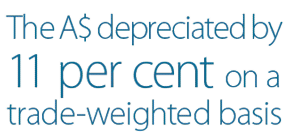
The Reserve Bank also transacts in the foreign exchange market when managing its foreign currency reserves. As discussed below, the relative weightings of foreign currencies within the Bank's portfolio are managed against a benchmark. To maintain the portfolio at these benchmark weights, or to accommodate discrete changes in the weights, the Bank will transact in spot foreign exchange. The final settlement of these rebalancing flows may be deferred through the use of foreign exchange swaps, whereby one currency is exchanged for another, with a commitment to unwind the exchange at a subsequent date at an agreed (forward) rate. Swaps can also be an efficient way to manage the shorter-dated portion of the reserves portfolio. During 2014/15, swaps transacted for these purposes totalled around US$66 billion.
As highlighted above, the Reserve Bank also makes use of foreign exchange swaps to manage liquidity in the domestic cash market. Swaps against Australian dollars do not affect the exchange rate but will alter the supply of ES balances in the same way as repos against Australian dollar-denominated securities. The swap market generally offers more liquidity than the domestic repo market, allowing the Bank more effectively to manage the impact of large projected changes in ES balances (such as those associated with government bond maturities). In 2014/15, $76.7 billion of foreign currency swaps were undertaken for domestic liquidity management.

Foreign currency swaps executed by the Reserve Bank are generally for no more than three months' duration. The risk associated with forward foreign exchange positions is mitigated by receiving collateral from (or, where appropriate, posting collateral to) the Bank's counterparties against changes in the market value of outstanding positions. The terms under which such collateral is exchanged are defined in two-way Credit Support Annexes to the ISDA Master Agreements that the Bank has executed with each of its foreign exchange counterparties (see the chapter on ‘Risk Management’ for details).
Reserves Management
Australia's official reserve assets include foreign currency assets, gold, Special Drawing Rights (SDRs – a liability of the IMF) and Australia's reserve position in the IMF. Reserve assets are held primarily to facilitate policy operations in the foreign exchange market (as discussed above). The capacity to undertake such operations is best measured by ‘net’ reserve assets, with the amount of foreign currency subject to forward commitments (such as foreign currency that the Reserve Bank has obtained from short-term swaps against Australian dollars) excluded.
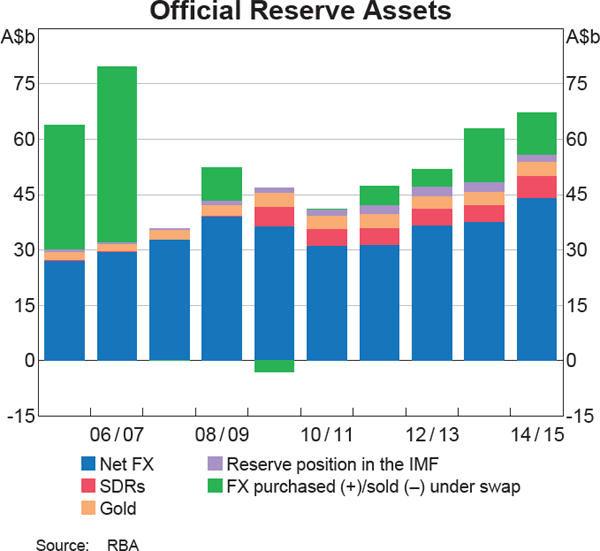
Australia's reserve position in the IMF is an asset of the Australian Government. All other components of Australia's official reserve assets are held on the Reserve Bank's balance sheet and the Bank is responsible for managing the level and composition of those reserves. As these assets can expose the Bank to various risks (such as market, liquidity and credit risk), the level held represents the amount assessed as necessary to meet potential policy requirements. Within that, the Bank seeks to mitigate risks to its balance sheet where possible, such as by holding a diversified portfolio of assets and investing only in assets of high credit quality and appropriate liquidity.
The composition of the Reserve Bank's foreign currency asset portfolio is guided by an internally constructed benchmark. This benchmark is assessed to be the combination of foreign currencies and foreign currency assets that will maximise the Bank's returns over the long run, subject to the Bank's risk tolerance. The structure of the benchmark is periodically reviewed to take account of significant changes in market conditions.
| US dollar | Euro | Japanese yen | Canadian dollar | Chinese renminbi | Pound sterling | |
|---|---|---|---|---|---|---|
| Currency allocation (per cent of total) | 55 | 25 | 5 | 5 | 5 | 5 |
| Duration (months) | 6 | 6 | 6 | 6 | 30 | 3 |
|
Source: RBA |
||||||
During 2014/15, the allocation to the Chinese renminbi within the foreign currency benchmark was increased from 3 per cent to 5 per cent, the US dollar allocation was increased from 52 per cent to 55 per cent and an allocation of 5 per cent was made to pound sterling. Within the benchmark, these changes were offset by a 10 per cent reduction in the euro share. These shifts further helped to diversify the Bank's foreign currency investments and are expected to enhance returns over the long run. The large weight of the US dollar in the foreign currency portfolio in part reflects the greater liquidity of that market.
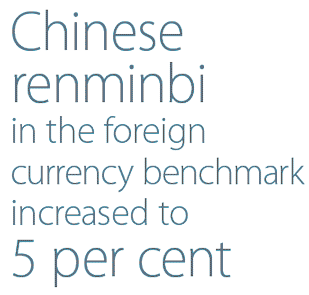
Reflecting the generally low level of global interest rates, duration targets have remained short for most of the foreign currency portfolios, with the target for euro investments reduced further during the year. Short duration targets will mitigate the risk of capital losses should bond yields return to more normal levels in these currencies. The duration target for the Chinese portfolio was raised in 2014/15 alongside the increased allocation to that currency to support replicability of the benchmark.
Investments within the benchmark currencies are limited to deposits at official institutions (such as central banks) and debt instruments issued or guaranteed by sovereigns, central banks, supranational agencies and (under reverse repo only) quasi sovereigns. Sovereign credit exposures are currently limited to the United States, Germany, France, the Netherlands, Canada, Japan, China and the United Kingdom.
| Currency | Securities held outright |
Securities held under reverse repos | Deposits at official institutions(b) |
Total | Forward FX commitments | Net | |
|---|---|---|---|---|---|---|---|
| Against AUD | Against other currencies | ||||||
| US dollar | 13,222 | 561 | 720 | 14,504 | −385 | 9,872 | 23,990 |
| Euro | 6,485 | 524 | 13 | 7,022 | −5 | 3,822 | 10,840 |
| Japanese yen | 28,860 | 1,224 | 58 | 30,142 | −11,278 | −16,682 | 2,183 |
| Canadian dollar | 1,172 | – | 5 | 1,178 | – | 1,003 | 2,181 |
| Chinese renminbi | 2,186 | – | 33 | 2,219 | – | – | 2,219 |
| Pound sterling | – | – | 1 | 1 | −3 | 2,253 | 2,251 |
| Total | 51,926 | 2,310 | 830 | 55,065 | −11,670 | 268 | 43,663 |
|
(a) Excludes investments in the Asian Bond Funds Source: RBA |
|||||||
At the end of June, the Reserve Bank's foreign currency reserves included $11.7 billion of foreign currency sourced from swaps against Australian dollars. Foreign currency obtained in this manner does not comprise part of the benchmark portfolio, but is invested to ensure that the Bank's forward commitments to sell foreign currency are fully hedged against currency and interest rate risk.
As has been the case for some years, when the costs of hedging currency risk are taken into account, yields on short-dated Japanese investments have generally exceeded those available in the other currencies within the Reserve Bank's portfolio. Reflecting this, almost all of the foreign currency the Bank obtains from swaps against Australian dollars is Japanese yen. For the same reason, the Bank also swaps other foreign currencies against the yen to enhance returns on its foreign reserves portfolio. As a consequence, while the Bank's exposure to changes in the value of the yen remains small (consistent with the yen's low share in the Bank's benchmark), around 55 per cent of foreign currency reserves were invested in yen-denominated assets at the end of June 2015. The swaps undertaken for return enhancement are of short duration, less than 100 days, and are staggered such that the average term to maturity is around one and a half months.
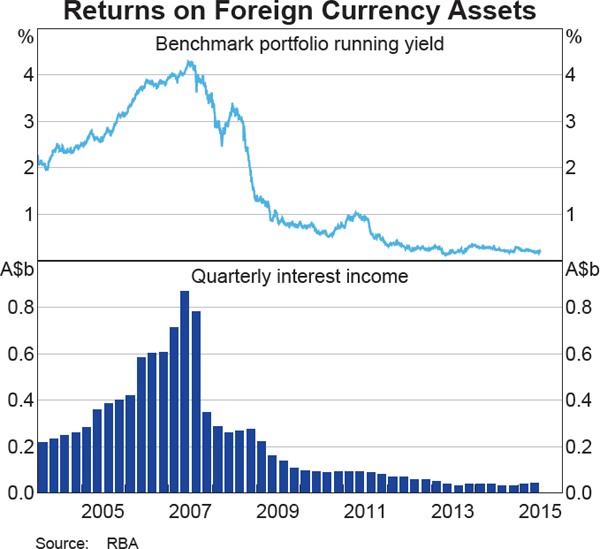

A small component of the Reserve Bank's net foreign currency reserves sits outside the benchmark framework. This encompasses investments in a number of Asian debt markets through participation in the EMEAP Asian Bond Fund Initiative, which was established in the wake of the Asian currency crisis in the late 1990s to assist in the development of bond markets in the region. The Bank has modest holdings in the US dollar-denominated fund (ABF1) and the local currency-denominated fund (ABF2). At the end of June 2015, the total allocation of reserves to these funds was $583 million. The return on these investments in 2014/15 was 10 per cent when measured in SDR terms.
Measured in SDRs, the overall return on the Reserve Bank's foreign currency assets in 2014/15 was 2.2 per cent, significantly higher than the previous year but still below historical norms. This outcome largely reflected the US dollar's appreciation against other benchmark currencies, with small contributions from interest income and capital gains on bond holdings. At the end of June 2015, the running yield on the benchmark portfolio was very low at 0.2 per cent, reflecting the historically low levels of global bond yields.
The Reserve Bank's holdings of SDRs at 30 June 2015 amounted to $5.9 billion, $1.2 billion higher than the previous year, reflecting net purchases of SDRs over the year and the depreciation of the Australian dollar. Under voluntary arrangements with the IMF, the Bank is willing to transact in SDRs upon request from other countries or prescribed holders. In these transactions, the Bank will generally either buy or sell SDRs in exchange for foreign currencies (such as euros or US dollars). While such transactions do not alter the level of Australia's reserve assets (only the proportions held in SDRs and foreign currency), the Bank occasionally chooses to replenish foreign currency sold in exchange for SDRs by purchasing additional foreign currency against Australian dollars in the spot market.
Australia's reserve position in the IMF was $1.8 billion at the end of June 2015. This is $0.7 billion lower than the previous year as a result of IMF member countries' loan repayments, which were only partly offset by exchange rate valuation effects. The reserve position comprises that part of Australia's quota in the IMF that was paid in foreign currency as well as other credit that Australia has extended to the IMF in support of its lending programs. As noted above, this asset is not held on the Reserve Bank's balance sheet. However, the Bank will sell to (or purchase from) the Australian Treasury the foreign currency the Treasury needs to complete its transactions with the IMF. Unlike the normal customer business transacted with the Australian Government, the Bank will typically draw on (or add to) its foreign currency reserves when providing foreign currency for this purpose. This is because any change to the Bank's holdings of foreign currency assets will be offset by an equivalent change in Australia's reserve position in the IMF, leaving total official reserve assets unchanged. Nevertheless, as with SDR transactions, on certain occasions the Bank may decide to offset the impact on foreign currency asset holdings of these IMF transactions by transacting in spot foreign currency against the Australian dollar.
Gold holdings at the end of June 2015 were around 80 tonnes, unchanged from the previous year. Gold prices rose by 9 per cent in Australian dollar terms over 2014/15, increasing the value of the Reserve Bank's holdings of gold by around $0.3 billion to $3.9 billion. The Bank had only 1 tonne of gold on loan during 2014/15, with income earned on that loan amounting to $0.1 million.
Bilateral Currency Swaps
In April 2015, the Reserve Bank renewed its bilateral local-currency swap agreement with the People's Bank of China. This follows the initial swap agreement between the two central banks signed in 2012 and is for a further period of three years. The agreement, which can be activated by either party, allows for the exchange of local currencies between the two central banks of up to A$40 billion or CNY 200 billion. The Reserve Bank has a similar local-currency swap arrangement with the Bank of Korea. These agreements are designed to support trade and investment between the respective countries, particularly in local-currency terms, and to strengthen bilateral financial cooperation.
Footnotes
See Baker A and D Jacobs (2010), ‘Domestic Market Operations and Liquidity Forecasting’, RBA Bulletin, December, pp 37–43. [1]
Total ES balances are typically $21 billion to $22 billion, of which around $20 billion is required to be maintained as contracted open repo positions; ES account holders typically have aggregate surplus balances of around $1 billion to $2 billion. For further details refer to the ‘Operations in Financial Markets’ chapter of the Annual Report for 2014. [2]
The CLF legal documentation is available at <http://www.rba.gov.au/mkt-operations/resources/tech-notes/pdf/clf-terms-and-conditions.pdf> and <http://www.rba.gov.au/mkt-operations/resources/tech-notes/clf-operational-notes.html>. [3]
These margins are listed on the Bank's website at <www.rba.gov.au/mkt-operations/resources/tech-notes/eligible-securities.html)> and are considerably higher for securities that are not issued by governments. [4]